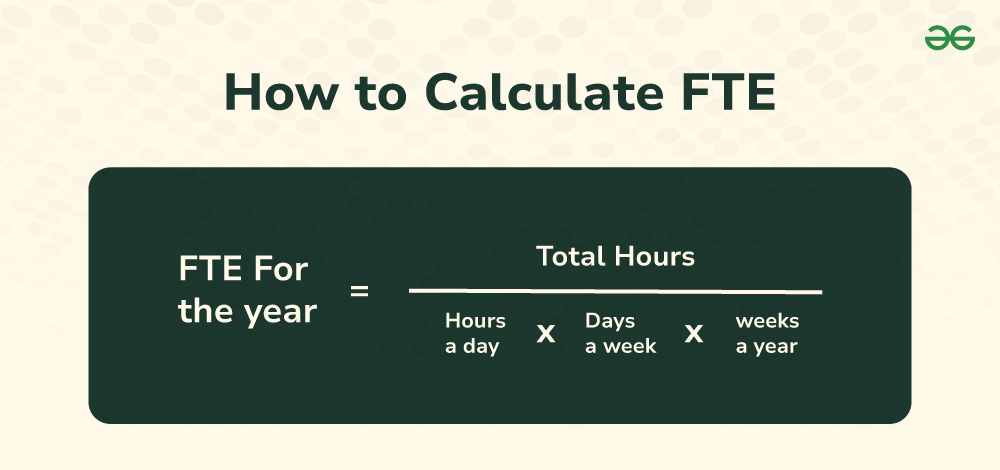How to Calculate FTE
Last Updated :
23 Apr, 2024
What does FTE stand for? FTE stands for full-time equivalent and it is the measure of how many total full-time employees or part-time employees add up to the full-time employees a company employs.
In this article, we’ll delve into what FTE means, why it matters, and how to calculate it.

What is Full-Time Equivalent (FTE)?
Full-Time Equivalent (FTE) represents a standardized unit of measurement that quantifies the productive capacity of employees. It answers the question: “How many full-time employees would be equivalent to the combined work of our current workforce?” FTE accounts for both full-time and part-time employees, allowing organizations to assess their staffing needs accurately.
Why Calculate FTE?
FTE is calculated because,
- Strategic Workforce Planning: FTE calculations help organizations plan their workforce strategically. By understanding the FTE, you can determine whether you need to hire additional staff, restructure existing roles, or optimize resource allocation.
- Compliance and Reporting: Labor laws and employee benefit programs often require FTE reporting. Accurate FTE calculations ensure compliance and facilitate transparent reporting.
- Resource Allocation: FTE informs budgeting and resource allocation decisions. It helps allocate resources efficiently, balancing workloads across teams.
How to Calculate Full-Time Equivalent (FTE)
The formula to calculate FTE is shown in the image added below:

Calculating FTE involves a straightforward process. Let’s break it down into four steps:
1. Count Number of Hours Worked by Part-Time Employees
Begin by tallying the total hours worked by part-time employees. For example, if you have three part-time employees working 20 hours each per week, the total part-time hours would be 60.
2. Count Number of Hours Worked by Full-Time Employees
Next, sum up the hours worked by full-time employees. If you have five full-time employees working 40 hours per week, the total full-time hours would be 200.
3. Add Total Hours Worked by Both Part-Time and Full-Time Employees
Combine the part-time and full-time hours. In our example, the total hours worked would be 260 (60 part-time hours + 200 full-time hours).
4. Calculate Total FTE
To calculate the FTE, divide the total hours worked by the number of available full-time hours in a year (usually 2,080 hours):
FTE = Total Hours Worked / Available Full-Time Hours in Year
How to Calculate FTE Examples
Example 1: What is the FTE of a workforce when they work 260 hours a year?
Solution:
- Total Hours Worked = 260
- Available Full-Time Hours in Year = 2080
FTE = 260 / 2,080
FTE = 0.125
Therefore, the FTE for this workforce is 0.125, indicating that it’s equivalent to 12.5% of a full-time employee.
Example 2: If an employee works 80 hours in a month, and the full-time hours for that month are 160, then the FTE would be 0.5.
FTE = 80 / 160
FTE = 0.125
Example 3: Consider a company with:
- 50 full-time employees working a standard 40-hour workweek (each with an FTE of 1.0)
- 10 part-time employees working 20 hours per week (each with an FTE of 20 hours / 40 hours = 0.5)
Total FTE = (50 employees × 1.0 FTE/employee) + (10 employees × 0.5 FTE/employee)
Total FTE = 50 FTE + 5 FTE
Total FTE = 55 FTE
Conclusion
Understanding and calculating FTE is crucial for effective workforce management and planning. It allows organizations to compare workloads and to plan for future hiring needs. Remember, while FTE is a useful measurement, it doesn’t account for productivity levels, so it should be used as one of many factors in workforce management.
FAQs on Full-Time Equivalent(FTE)
What is 0.9 FTE?
A 0.9 FTE value represents what fraction of a full-time employee would work. i.e. 9.9 FTE means an employee works 90% of hours available in a week.
What is the difference between FTE and headcount?
- Headcount is the total number of employees working in a company, including both part-time and full-time employees.
- Wheras FTE refers to the number of hours worked by each employee.
What does FTE 100% mean?
FTE 100% refers to a full-time employee or the equivalent of a full-time employee. Generally, this means the employee works 40 hours.
Can FTE be calculated for less than a full workweek (e.g., daily)?
Yes, simply adjust the denominator in your calculations to reflect the desired timeframe (e.g., number of hours in a workday).
What are some real-world applications of FTE?
FTE is used in workforce planning, budgeting, workload distribution, analyzing staffing efficiency, and complying with regulations that consider employee count.
Can FTE be greater than 1.0?
Yes, if an employee consistently works overtime, their FTE can exceed 1.0.
How does FTE impact budgeting?
Accurate FTE calculations guide budget allocation, ensuring optimal resource utilization.
What does a FTE of 1.0 mean?
A FTE of 1.0 means that the person is equivalent to a full-time worker.
How is FTE calculated?
FTE is calculated by dividing the total hours worked by the maximum monthly full-time hours.
Is FTE calculated monthly or annually?
FTE can be calculated on a monthly or annual basis, depending on the reporting requirements of the organization.
Share your thoughts in the comments
Please Login to comment...